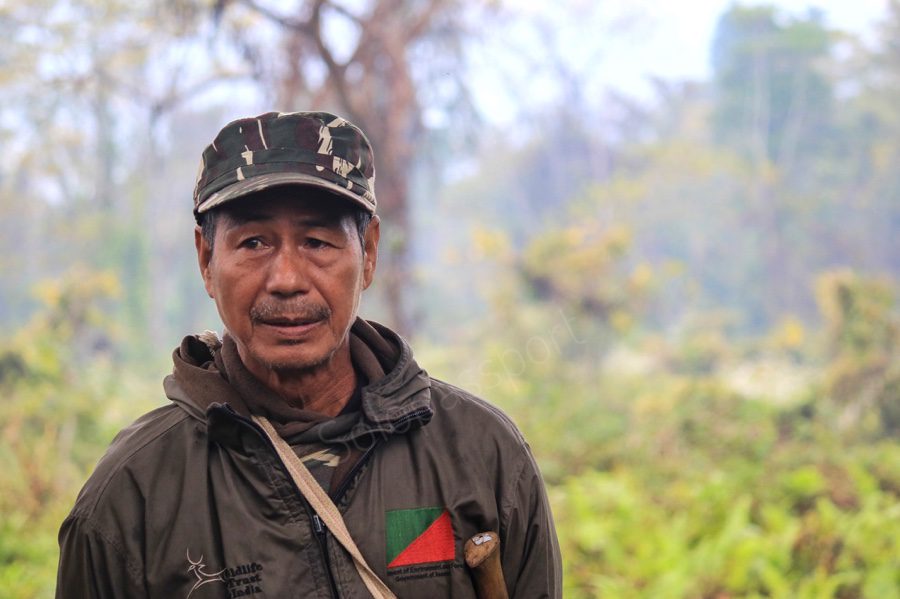Story of ex-Poachers at Manas National Park (2024)
Throughout our upbringing, we’ve been immersed in tales that champion the triumph of good over evil. Elders and educators instill in us the power of positive actions to counteract wrongdoing. While such narratives are commonplace in movies and shows, witnessing these principles in real life is a rarity. My encounters had been limited to fictional portrayals on screen. However, a unique opportunity unfolded during my ten-day journey through Bodoland. I crossed paths with four former poachers at Manas National Park, eventually interviewing with one of them.
Also Visit – Pobitora Wildlife Sanctuary
The intrigue deepened as I sought to unravel the transformation from poacher to wildlife protector. What catalysts prompted these individuals to change their ways? Delving into the history behind this narrative, I pondered the story’s authenticity. Could such a profound shift occur in reality, or was it merely a fantastical tale akin to those depicted on screen? These questions fueled my exploration of a narrative that blurred the lines between fiction and the tangible transformations that can manifest in the intricacies of human experience.
Page Contents
PIN for later reference (Story of ex-poachers at Manas National Park)

This article may contain affiliate links, meaning if you decide to purchase via my links, I may earn a commission at no additional cost to you. For complete information, please see our affiliate disclaimer here.
History of Poaching at Manas National Park
In Assam, Manas National Park, alternatively recognized as Manas Tiger Reserve, attained UNESCO World Heritage Site status in 1985.

Unfortunately, the Manas National Park fell prey to the armed conflict over establishing a separate Bodoland state, resulting in its separation from Assam. Manas also suffered from rampant poaching driven by the demand for rhino horns and valuable timber from the forests. Adding to the predicament, no official authority was willing to approach the park. The situation deteriorated, so UNESCO deemed it necessary to classify Manas as a World Heritage Site in danger.
In the late 1980s Manas’s 100 Rhinos were killed and park infrastructure damaged by insurgents. This led World Heritage Committee to put Manas in danger list in 1992. In 2011, Manas got back World Heritage Site status for success conservation, and reintroduction of rhinos was one of the factors.
Economic Times Article – 6 May 2016
In the early 2000s, the entire flora and fauna vanished, with the unfortunate loss of all rhinos and the widespread destruction of most forests.
Poacher’s Story: Interview with a Poacher
During our visit to Manas National Park, I encountered four individuals with a history of poaching. One member of the group had engaged in poaching for 25 years, claiming the lives of approximately 100 elephants. Another poacher had suffered the loss of one arm due to an encounter with a wild boar while on a hunting expedition.

When questioned about the motives behind their reprehensible actions, the prevailing response was a dire lack of financial resources. Faced with poverty and limited employment opportunities, they felt compelled to resort to killing animals.
Subsequently, our curiosity led us to inquire about the monetary gains from poaching. The poachers revealed that the mastermind or head of the operation, who ordered the killing of an animal, would receive Rs. 2 lakhs for a rhino horn. In contrast, the entire group of poachers collectively earned Rs. 15,000 to 20,000 for their involvement in the illicit activity. Typically, a Rhino’s killing would involve a group of 4 to 5 poachers.
Who brought in the change?
Motivated by the deteriorating state of their home, Manas, which was being ravaged before their eyes, the local Bodo villagers took decisive action. In collaboration with the student council, they established the NGO ‘Manas Maozigendri Ecotourism Society’ in December 2003. The primary objective of this society was safeguarding Manas, its forests, and its wildlife.
Determined society volunteers initially identified the poachers responsible for the environmental degradation, many of whom hailed from the local village or neighboring villages. The volunteers visited the homes of these poachers, engaging in conversations aimed at education and persuasion to relinquish their homemade weapons. The poachers underwent counseling to transform them into protectors of the forests.
I get a lot of sukoon (satisfaction) when I see a poacher becoming a protector.
Says Kalen, President of Manas Moazigendri Eco Tourism Socienty.
During my interview with Kalen, the President of Manas Maozigendri Eco-Tourism Society, I discovered his unwavering belief in and commitment to this transformative initiative. When queried about their challenges, he acknowledged facing numerous obstacles, including death threats. However, these challenges did not deter their resolve. Kalen’s singular objective remained clear: to protect Manas at all costs.

The Manas Moazigendri Eco-Tourism Society has garnered numerous accolades for its accomplishments. Notable among these awards are the Anirudh Bhargava INTACH Environment Award in 2005 and the Amrita Devi Bishnoi Wildlife Protection Award in 2006.
What do these ex-poachers currently do at Manas National Park?
Transformed from poachers into dedicated conservationists, these individuals now play a pivotal role in safeguarding wildlife and the forest. Their efforts involve patrolling the habitat, utilizing elephants to navigate core areas, and ensuring the rescue and protection of distressed animals. Remarkably, the ex-poachers receive a monthly stipend of Rupees 6,000, surpassing the earnings they once garnered from poaching.
During the interview, one of the former poachers expressed a newfound sense of pride. Today, he stands proudly in front of his children, free from the shame that accompanied his days as a poacher.
How Can You Help Manas?
Ecotourism has emerged as a crucial avenue for supporting Manas and enhancing the livelihoods of the local Bodo community. Accommodations, including camps and cottages situated on the periphery of Manas, provide visitors with a unique experience.
The Manas Moazigendri Ecotourism Society organizes various activities, including jeep safaris and forest trekking, allowing visitors to explore the area’s natural beauty. Additionally, the society arranges cultural activities such as local singing and dancing, providing a holistic and immersive experience for those eager to connect with the region’s rich heritage.
How to Get to Manas National Park?
Situated in the Bhuyanpara Range within Manas, the Manas Moazigendri Ecotourism Society finds its location near the Kaklabari Central Seed Farm. Approximately 175 kilometers from Guwahati, Manas is accessible by road, taking around 3 hours to reach. The nearest airport is also in Guwahati, providing convenient access to this ecotourism destination.
Where to Stay at Manas National Park?
During my visit, I lodged at ‘Smiling Tusker Resort,’ situated on the park’s periphery. The staff at the resort were exceptionally amiable, ensuring our well-being and providing excellent hospitality throughout our stay.
Safety for Tourists at Manas National Park
Traveling to Manas is unequivocally secure. The resorts and camps, both in the vicinity and within the national parks, guarantee high safety and protection, ensuring visitors’ safe and worry-free experience.

Closing Notes
Today, Manas is a testament to a remarkable resurgence, transforming from obscurity into a renowned and flourishing national park in India. It sets a precedent for other national parks nationwide, radiating positive stories and vibes. UNESCO’s removal of Manas from the danger list and its acknowledgment as a World Heritage Site reflect its significant progress.
While the park still has a journey ahead to reclaim its 1985 status, the tangible change is undeniable and challenging. As a wildlife enthusiast, I harbored a deep disdain for poachers, deeming them undeserving of redemption. Witnessing these individuals evolve into wildlife conservationists and protectors was an unexpected revelation, challenging preconceived notions and offering hope for positive transformation.
I thank the Assam Tourism Board and Bodoland Tourism for extending this opportunity and hosting me. This journey has been enlightening, allowing me to reconsider and appreciate the positive aspects of my surroundings.
How can you support me?
You know how much I love coffee, so you can buy me a coffee – Buy me Coffee!
Or you can purchase from one of the below travel resources without any extra charge to you:
Travel Resources
Book your flight on Skyscanner.com or Trip.com
Reserve your accommodation on Stay22
Reserve your stay at a hostel on HostelWorld
Use RentalCars or DiscoverCars for hiring self-driven cars
Book your tours and travels or purchase tickets on Viator or GetYourGuide
For a universal SIM card, use DrimSim
Buy comprehensive travel insurance on SafetyWing and WorldNomads
If you liked this article and if it was helpful in your planning or travelling, do share, tweet, or pin this post.
Follow me on Instagram | Facebook | YouTube | Twitter | LinkedIn
Do you have a question? Do you want any suggestions and tips for travel, hikes, and scuba dives? Use the Subscription box below to sign up and get updates by email.
PIN for later reference


